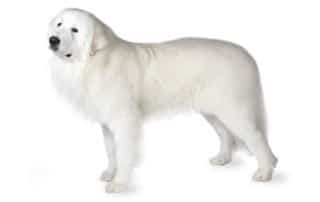
The Great Pyrenees is an majestic and loyal large dog breed that originated in the mountains surrounding the Pyrenees Mountains between France and Spain. They were originally used as protection dogs, as they would roam and guard flocks of sheep. The Great Pyrenees stands between 27-32 inches and weighs an average of 85-120 pounds. They have a double coat that consists of a thick, coarse outer coat and a soft, dense undercoat. The outer coat is moderately long and is traditionally white in color, although some have tints of light tan or gray. The breed is further defined by feathering around the neck, called a “ruff”, and along the backs of their legs and tail. The muzzle is moderately thick and the nose is black. Their ears are medium-sized and tipped slightly forward. They have round and medium-sized eyes that are usually dark brown.
The breed is widely known for its loyalty and has been said that they will protect their people and possessions to the point of sacrificing their own life. The Great Pyrenees likely descended from ancient mammoth mastiff-type dogs and non-mastiff mountain dogs from Asia and India. It is believed that during the middle ages, they were bred with several different breeds such as the St. Bernard, the Newfoundland, and the Briard. What makes the Great Pyrenees so special is their combination of beauty and protectiveness. Their serene and loyal temperaments make them great family dogs, and their large amount of energy makes them perfect partners for traveling and outdoor activities.
The Great Pyrenees is a large and majestic dog breed known for its kind and gentle nature. Highly intelligent, these dogs make great family pets who are willing to please their owners. They are patient and tolerant of children, and get along quite well with other household pets. Early training and socialization are essential for the Great Pyrenees to thrive, as this helps them learn appropriate behavior. They have medium to high levels of energy, and need regular exercise for physical and mental well-being. Although they are large in size, Great Pyrenees do well living indoors provided they receive sufficient outdoor exercise. Regular walks, fun runs, and playtime sessions are all suitable activities for them. What’s more, these dogs are known to form strong and life-long bonds with their owners, and make truly loyal companions.
The Great Pyrenees is a large, majestic breed of dog that is known for its luxurious double coat of white fur and calm demeanor. They are known as gentle giants and are loyal, always protective, and an excellent choice for any home with children and other animals. As a large breed, the Great Pyrenees nutrition requirements are specific and these dogs should be fed a high-quality dog food that is tailored to meet their needs. The food should be rich in proteins, carbohydrates, and essential fatty acids, as well as being well-balanced. Additionally, when feeding puppies, it’s important to follow specific feeding guidelines for their age. Appropriate portion size, feedings, as well as the type of food and treats, can help ensure a puppy grows at the right rate.
A healthy diet is essential for any dog to remain healthy and active for a longer lifespan and the Great Pyrenees is no exception. Responsible dog owners should follow the right feeding guidelines and if you are a new owner of a Great Pyrenees do check out Way Canina to find out more about their nutritional needs and which foods this breed should avoid.
Great Pyrenees are loyal and protective dogs that do need a special diet to remain healthy and active. Following the feeding guidelines for the age and size of the dog, as well as offering high-quality food specific for large breeds, can help ensure your dog stays healthy and happy. New owners of this breed should visit Way Canina and find out more about their specific nutritional requirements.
A balanced diet with an appropriate portion size and regular exercise are essential to preventing obesity. Grooming is also important for this breed, which includes brushing, bathing, and ear cleaning. Proper grooming helps to reduce the risk of skin problems, mats, and other issues. With proper care and attention, you can help your Great Pyrenees enjoy a long, healthy life.
Great Pyrenees typically have an average lifespan of 10-12 years, but their longevity can be affected by factors such as genetics, diet, exercise, and healthcare. To ensure optimal health, it is important to take your Great Pyrenees to the vet for regular check-ups, vaccinations, and preventive care.
Do you own a Great Pyrenees or are you thinking about getting one? Owning any type of dog comes with a lot of responsibility and commitment, and every breed of dog also has its own unique set of pros and cons. Why not compare different breeds and find out which one is right for you? Make sure to check out our blog posts and articles on Way Canina for more information on different breeds of dogs and their lifestyle and wellbeing.